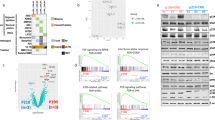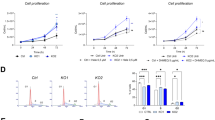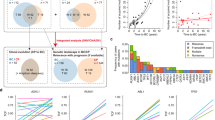Abstract
The BCR-ABL oncogenic tyrosine kinase causes chronic myeloid leukemia and is the target for imatinib therapy. During imatinib treatment, cells are selected in some patients with BCR-ABL kinase domain mutations that render decreased drug sensitivity. In addition, some patients express deletion mutants of BCR-ABL, apparently due to missplicing. Most commonly these deletion mutants lack a significant portion of the kinase domain that includes the P-loop. We describe a screen for such mutations in patients with CML and demonstrate that they are not oncogenic and are catalytically inactive. We hypothesized that coexpressing BCR-ABL deletion mutants has a dominant-negative effect on the native form through heterocomplex formation. However, upon coexpression of native and deletion mutant BCR-ABL in Ba/F3 cells, growth factor independence is maintained and signaling is activated normally. Despite this, these cells have increased imatinib sensitivity compared to cells expressing only native BCR-ABL. Thus, it will be important to investigate the prognostic impact of coexpression of deletion mutants in CML patients during imatinib treatment.
This is a preview of subscription content, access via your institution
Access options
Subscribe to this journal
Receive 12 print issues and online access
$259.00 per year
only $21.58 per issue
Buy this article
- Purchase on Springer Link
- Instant access to full article PDF
Prices may be subject to local taxes which are calculated during checkout




Similar content being viewed by others
References
von Bubnoff N, Manley PW, Mestan J, Sanger J, Peschel C, Duyster J . Bcr-Abl resistance screening predicts a limited spectrum of point mutations to be associated with clinical resistance to the Abl kinase inhibitor nilotinib (AMN107). Blood 2006; 108: 1328–1333.
Gruber FX, Hjorth-Hansen H, Mikkola I, Stenke L, Johansen T . A novel Bcr-Abl splice isoform is associated with the L248V mutation in CML patients with acquired resistance to imatinib. Leukemia 2006; 20: 2057–2060.
Khorashad JS, Lipton JH, Marin D, Milojkovic D, Cross NCP, Dibb N et al. Abnormally small BCR-ABL transcripts in CML patients before and during imatinib treatment. Blood 2006; 108: 611a (abstract [2153]).
Volpe G, Cignetti A, Panuzzo C, Kuka M, Vitaggio K, Brancaccio M et al. Alternative BCR/ABL splice variants in Philadelphia chromosome-positive leukemias result in novel tumor-specific fusion proteins that may represent potential targets for immunotherapy approaches. Cancer Res 2007; 67: 5300–5307.
McWhirter JR, Galasso DL, Wang JY . A coiled-coil oligomerization domain of Bcr is essential for the transforming function of Bcr-Abl oncoproteins. Mol Cell Biol 1993; 13: 7587–7595.
Zhao X, Ghaffari S, Lodish H, Malashkevich VN, Kim PS . Structure of the Bcr-Abl oncoprotein oligomerization domain. Nat Struct Biol 2002; 9: 117–120.
Press RD, Love Z, Tronnes AA, Yang R, Tran T, Mongoue-Tchokote S et al. BCR-ABL mRNA levels at and after the time of a complete cytogenetic response (CCR) predict the duration of CCR in imatinib mesylate-treated patients with CML. Blood 2006; 107: 4250–4256.
Willis SG, Lange T, Demehri S, Otto S, Crossman L, Niederwieser D et al. High-sensitivity detection of BCR-ABL kinase domain mutations in imatinib-naive patients: correlation with clonal cytogenetic evolution but not response to therapy. Blood 2005; 106: 2128–2137.
Deininger MW, McGreevey L, Willis S, Bainbridge TM, Druker BJ, Heinrich MC . Detection of ABL kinase domain mutations with denaturing high-performance liquid chromatography. Leukemia 2004; 18: 864–871.
Barila D, Superti-Furga G . An intramolecular SH3-domain interaction regulates c-Abl activity. Nat Genet 1998; 18: 280–282.
La Rosee P, Corbin AS, Stoffregen EP, Deininger MW, Druker BJ . Activity of the Bcr-Abl kinase inhibitor PD180970 against clinically relevant Bcr-Abl isoforms that cause resistance to imatinib mesylate (Gleevec, STI571). Cancer Res 2002; 62: 7149–7153.
Hantschel O, Nagar B, Guettler S, Kretzschmar J, Dorey K, Kuriyan J et al. A myristoyl/phosphotyrosine switch regulates c-Abl. Cell 2003; 112: 845–857.
Pluk H, Dorey K, Superti-Furga G . Autoinhibition of c-Abl. Cell 2002; 108: 247–259.
O'Hare T, Pollock R, Stoffregen EP, Keats JA, Abdullah OM, Moseson EM et al. Inhibition of wild-type and mutant Bcr-Abl by AP23464, a potent ATP-based oncogenic protein kinase inhibitor: implications for CML. Blood 2004; 104: 2532–2539.
Zheng J, Knighton DR, ten Eyck LF, Karlsson R, Xuong N, Taylor SS et al. Crystal structure of the catalytic subunit of cAMP-dependent protein kinase complexed with MgATP and peptide inhibitor. Biochemistry 1993; 32: 2154–2161.
Hantschel O, Superti-Furga G . Regulation of the c-Abl and Bcr-Abl tyrosine kinases. Nat Rev Mol Cell Biol 2004; 5: 33–44.
Klucher KM, Lopez DV, Daley GQ . Secondary mutation maintains the transformed state in BaF3 cells with inducible BCR/ABL expression. Blood 1998; 91: 3927–3934.
Waller CF, Dennebaum G, Feldmann C, Lange W . Long-template DNA polymerase chain reaction for the detection of the bcr/abl translocation in patients with chronic myelogenous leukemia. Clin Cancer Res 1999; 5: 4146–4151.
Schindler T, Bornmann W, Pellicena P, Miller WT, Clarkson B, Kuriyan J . Structural mechanism for STI-571 inhibition of abelson tyrosine kinase. Science 2000; 289: 1938–1942.
Nagar B, Hantschel O, Young MA, Scheffzek K, Veach D, Bornmann W et al. Structural basis for the autoinhibition of c-Abl tyrosine kinase. Cell 2003; 112: 859–871.
PyMol Homepage. http://pymol.sourceforge.net/.Accessed July 17, 2007.
Acknowledgements
Supported in part by NHLBI Grant HL082978-01 (MWD), Doris Duke Charitable Foundation (BJD) and the Leukemia and Lymphoma Society (BJD, MWD).
Author information
Authors and Affiliations
Corresponding author
Additional information
Supplementary Information accompanies the paper on the Leukemia website (http://www.nature.com/leu)
Supplementary information
Rights and permissions
About this article
Cite this article
Sherbenou, D., Hantschel, O., Turaga, L. et al. Characterization of BCR-ABL deletion mutants from patients with chronic myeloid leukemia. Leukemia 22, 1184–1190 (2008). https://doi.org/10.1038/leu.2008.65
Received:
Revised:
Accepted:
Published:
Issue Date:
DOI: https://doi.org/10.1038/leu.2008.65
Keywords
This article is cited by
-
A case report of a truncated ABL1 mutation in 2 cases with Philadelphia chromosome-positive B cell precursor acute lymphoblastic leukemia
International Journal of Hematology (2024)
-
Molecular remission after combination therapy with blinatumomab and ponatinib with relapsed/refractory Philadelphia chromosome-positive acute lymphocytic leukemia: two case reports
Journal of Medical Case Reports (2021)
-
ABL1 tyrosine kinase domain mutations in chronic myeloid leukemia treatment resistance
Molecular Biology Reports (2019)
-
Clonal distribution of BCR-ABL1 mutations and splice isoforms by single-molecule long-read RNA sequencing
BMC Cancer (2015)
-
Characterization of ABL exon 7 deletion by molecular genetic and bioinformatic methods reveals no association with imatinib resistance in chronic myeloid leukemia
Medical Oncology (2012)



